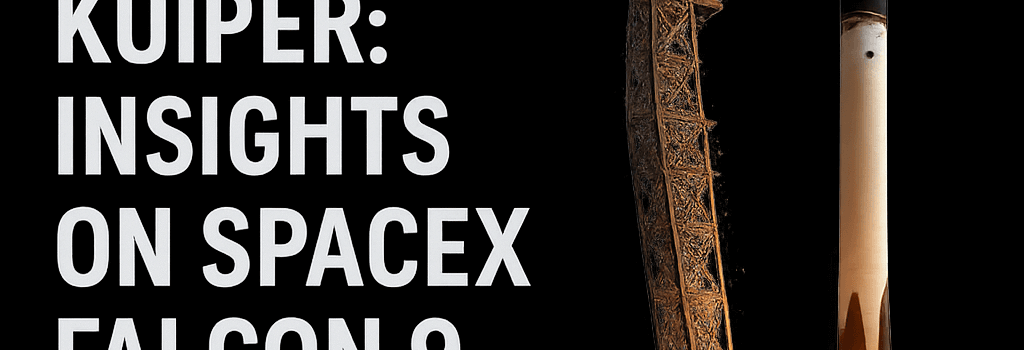Amazon’s Project Kuiper: Insights on SpaceX Falcon 9 Collaboration

Updated Jul 16, 2025 — Enhanced coverage including propulsion systems, launch strategy, and regulatory context.
Up and Away: KF-01 Launch Overview
At 2:30 am EST (06:30 UTC) on July 16, 2025, a SpaceX Falcon 9 rocket thundered off the pad at Cape Canaveral Space Force Station carrying 24 Amazon Project Kuiper broadband satellites. This mission, designated KF-01, marks Amazon’s first utilization of SpaceX launch services and brings the total Kuiper fleet in orbit to 78 of the planned 3,232 spacecraft.
“Deploying these satellites is a critical milestone toward achieving global low-latency internet coverage,” said a senior Amazon aerospace engineer.
Mission Profile and Orbital Insertion
- Launch Vehicle: SpaceX Falcon 9 Block 5 (B1077.2)
- Launch Site: SLC-40, Cape Canaveral Space Force Station, Florida
- Payload: 24 Kuiper satellites, ~285 kg each, total ~6.8 metric tons
- Target Orbit: 51.9° inclination, initial insertion at 465 km altitude
After first-stage separation, the Falcon 9’s upper stage completed a ~60-minute coast before releasing the satellites. Each spacecraft will employ Hall-effect electric thrusters to conduct orbit-raising maneuvers up to 630 km operational altitude over several weeks.
Technical Deep Dive: Kuiper Satellite Propulsion and Design
Each Kuiper spacecraft integrates a 200 W electric propulsion module, using krypton propellant. This choice balances cost and efficiency by enabling a specific impulse (Isp) of ~1,500 s, reducing launch mass compared to xenon systems.
- Power System: Deployable solar arrays generating up to 2.5 kW peak output.
- Communication Payload: Ka-band phased-array antennas with beamforming capability for dynamic bandwidth allocation.
- Attitude Control: Reaction wheels supplemented by magnetorquers for momentum dumping.
Manufactured in Kirkland, Washington, the facility now churns out ~3–4 satellites per week, targeting a future rate of five per day. It is second only to SpaceX’s Redmond Starlink plant.
Launch Vehicle Procurement Strategy Analysis
Initially, Amazon reserved 68 flights across ULA’s Atlas V and Vulcan, Arianespace’s Ariane 6, and Blue Origin’s New Glenn. However, pad availability constraints and Space Force missions left a gap in 2025. Under shareholder pressure and an FCC extension bid, Amazon inked a contract for three Falcon 9 missions in December 2023.
With ULA’s Atlas V pad occupied until late 2025 and Vulcan’s pad build-out ongoing, SpaceX remains Amazon’s sole short-term launch partner. Ariane 6’s two successful flights in Q2 2025 demonstrated reliability but limited cadence (2–3 launches/year). New Glenn awaits its repeat flight to prove rapid turnaround capabilities.
Regulatory and Market Implications
The FCC mandates that Amazon launch at least half of its Kuiper constellation by July 2026. Facing production delays early on and now launch slot scarcity, Amazon has filed for a six-month extension, citing “extraordinary supply-chain and scheduling constraints.”
Meanwhile, SpaceX’s Starlink network has soared past 8,000 active satellites after a July 16 launch from Vandenberg, underscoring the competitive pressure on Amazon to accelerate deployments and achieve global low-latency coverage.
Expert Perspectives
- Satellite Manufacturing: Dr. Elena Martinez, aerospace systems expert, notes that “Kuiper’s modular bus design streamlines production but requires high-volume procurement of electronics and propulsion units.”
- Market Competition: Telecom analyst Raj Patel observes, “Kuiper’s phased-array beams could offer greater resiliency than Starlink’s single-beam nodes, but only if Amazon can match SpaceX’s deployment rate.”
Outlook and Next Steps
Amazon plans to resume Atlas V launches in Q4 2025, followed by a Vulcan first Kuiper mission. Concurrent pad upgrades at Cape Canaveral aim to increase ULA’s launch cadence to 12–14 missions per year. Until then, SpaceX Falcon 9 remains the linchpin for Kuiper’s ambitious schedule.